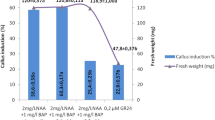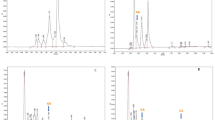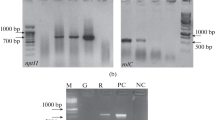Abstract
Centella asiatica has been extensively studied but there has been no report to date that relates gene expression and centelloside production in non-differentiated tissues. We have determined the content of the four principal triterpenoid bioactive compounds of C. asiatica (asiaticoside, madecassoside, asiatic acid and madecassic acid) in calli grown in different media and checked the expression level of some of the genes in the centelloside biosynthetic pathway. The results when compared with data from in vitro plant cultures showed a significantly lower expression of the gene encoding β-amyrin synthase in calli, which is consistent with the observed lower production of centellosides (less than 900 μg/g DW), while in the plants the production was around 1.5–2 mg/g DW. Moreover, we find an efficient housekeeping gene for this plant. The biosynthesis of phytosterols is also discussed.





Similar content being viewed by others
Abbreviations
- 4PU-30 :
-
N-(2-chloro-4-pyridyl)-N′-phenylurea
References
Banerjee S, Zehra M, Kumar S (1999) In vitro multiplication of Centella asiatica, a medicinal herb from leaf explants. Curr Sci 76:147–148
Bonfill M, Mangas S, Cusidó RM, Osuna L, Piñol MT, Palazón J (2006) Identification of triterpenoid compounds of Centella asiatica by thin layer chromatography and mass spectrometry. Biomed Chrom 20:151–153
Chakrabarty T, Deshmukh S (1976) Centella asiatica in the treatment of leprosy. Sci Cult 42:573
Inamdar PK, Yeole RD, Ghogare AB, de Souza NJ (1996) Determination of biologically active constituents in Centella asiatica. J Chromagr 742:127–130
Kim OT, Kim MY, Hong MH, Ahnn JC (2004) Stimulation of asiaticoside accumulation in the whole plant cultures of Centella asiatica (L.) Urban by elicitors. Plant Cell Rep 23:339–344
Kim OT, Kim MY, Huh SM, Bai DG, Ahn JC, Hwang B (2005a) Cloning of a cDNA probably encoding oxidosqualene cyclase associated with asiaticoside biosynthesid from Centella asiatica (L.) Urban. Plant Cell Rep 23:304–311
Kim OT, Kim MY, Hwang SJ, Ahn JC, Hwang B (2005b) Cloning and molecular analysis of cDNA encoding cycloartenol synthase from Centella asiatica (L.) Urban. Biotechnol Bioprocess Eng 10:16–22
Kim OT, Seong NS, Kim MY, Hwang B (2005c) Isolation and characterization of squalene synthase cDNA from Centella asiatica (L.) Urban. J Plant Biol 48:263–269
Mangas S, Bonfill M, Osuna L, Moyano E, Tortoriello J, Cusidó RM, Piñol MT, Palazón J (2006) The effect of methyl jasmonate on triterpene and sterol metabolisms of Centella asiatica, Ruscus aculeatus and Galphimia glauca cultured plants. Phytochemistry 67:2041–2049
Matsuda H, Morikawa T, Ueda U, Yoshikawa M (2001) Medicinal Foodstuffs. XXVII. Saponin Constituents of Gotu Kola (2): Structures of New Ursane- and Oleanane- Type Triterpene Oligoglycosides, Centellasaponins B, C and D, from Centella asiatica Cultivated in Sri Lanka. Chem Pharm Bull 49:1368–1371
Murashige T, Skoog F (1962) A revised medium for rapid growth and bioassay with tobacco tissue cultures. Physiol Plant 15:473–497
Nath S, Buragohain AK (2005) Establishment of callus and cell suspension cultures of Centella asiatica. Biol Plant 49:411–413
Nes WR, Heftmann E (1981) A comparison of tritrpenoids with sterols as membrane components. J Nat Prod 44:337–400
Patra A, Rai B, Rout GR, Das P (1998) Successful plant regeneration from callus cultures of Centella asiatica (Linn.) Urban. Plant Growth Regul 24:13–16
Piñol MT, Palazón J, Altabella T, Serrano M (1987) Effects of growth regulator 4PU-30 on growth, K+ content, and alkaloid production in tobacco callus cultures. J Plant Growth Regul 5:183–189
Solet JM, Simón-Ramiasa A, Cosson L, Guignard JL (1986) Centella asiatica (L.) Urban. (Pennywort): Cell Culture, Production of Terpenoids, and Biotransformation Capacity. In: Bajaj YPS (ed) Biotechnology in agriculture and forestry: Medicinal and aromatic plants X. Springer-Verlag, Berlin, Heidelberg
Acknowledgements
We thank Dr Ruxian Ding from the School of Pharmacy, Second Military Medical University (Shangai, China) for the C. asiatica seeds, and the Technical Science Service from Barcelona University for their support. This research has been supported by grants from the Spanish MEC (BIO2002-03614; BIO2002-02328; BIO2005-05583). L. Osuna is grateful for her research grant (PIV) from the “Generalitat de Catalunya”.
Author information
Authors and Affiliations
Corresponding author
Rights and permissions
About this article
Cite this article
Mangas, S., Moyano, E., Osuna, L. et al. Triterpenoid saponin content and the expression level of some related genes in calli of Centella asiatica . Biotechnol Lett 30, 1853–1859 (2008). https://doi.org/10.1007/s10529-008-9766-6
Received:
Revised:
Accepted:
Published:
Issue Date:
DOI: https://doi.org/10.1007/s10529-008-9766-6




